B2B New Product Innovation: Time for Ridiculously Large Profits

Have you noticed that all B2B new product innovation is not equal? Some new products deliver enormous profits for years or even decades, carrying whole businesses and careers on their sturdy shoulders. And then there are the tired, the poor, the huddled masses of wretched new products you wish were on your competitors’ teeming shores.
B2B New Product Innovation: What is the difference maker?
What separates them? Our work at AIM indicates blockbuster products must meet six conditions, not just four or five. That would be like getting four or five digits right in a six-digit lottery… after you paid a lot to play.
Click here to learn 12 Rules for High-Impact New Product Ideas
It’s rare for a product to nail all six conditions. Let’s consider four of the most common and damaging failure modes to keep our B2B new product innovation on track.
Four Failure Modes
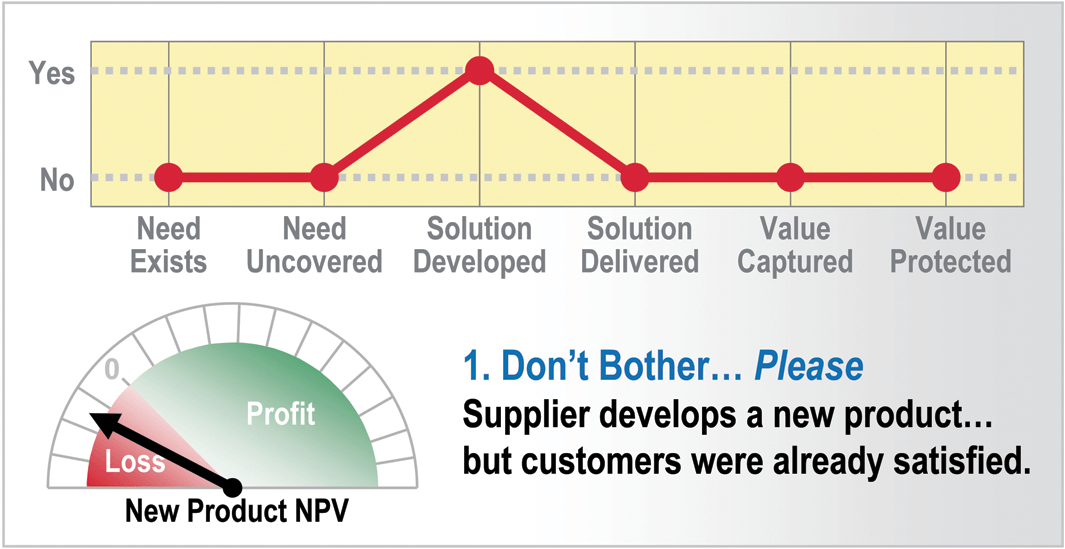
Failure #1: Don’t Bother… Please No significant need exists: Customers in the target market segment are content with what they have today. (Sure, they’d like lower prices… that never goes away.) As illustrated, the out-of-touch supplier develops a solution for an imaginary need. The spending to develop this product creates negative net present value (NPV) for the supplier.
Failure #2: Nice Shot, Wrong Target In this case, the customers have very real unmet needs. Our supplier misses these, instead developing a product based on internal, preconceived notions and a desire to push his really cool technology. If the repairman fixed your washing machine when your dryer was broken, would you pay him? Neither will these customers.
Failure #3: Right Product, Wrong Price Now our supplier is doing better: Customers are happy because he uncovered and met their important needs. Maybe too happy. He identified their needs, but didn’t understand how much value customers would reap using his product. As a result he left a lot of money on the table when he set his product pricing. The best B2B new product innovation not only creates value for customers, but it captures a share back for the business.
Failure #4: Here Today, Gone Tomorrow Solid NPV is delivered due to good market homework, good problem solving and good pricing. This has not gone unobserved by competitors. Unfortunately, our supplier has not blocked them using patents or other means… preventing a good financial story from becoming a great one.
When does the B2B vs. B2C distinction REALLY matter? Click here to learn more.
Changing Your Company
What’s holding back B2B new product innovation at your business? What if you could change the company DNA so new product teams habitually drive for all six conditions? Sound tough? It actually isn’t so complex if you notice a repeating pattern in each failure mode: It’s all about the up-front work. Put another way, the left side of each failure mode graph drives the right side:
- Don’t Bother… Please You should quantitatively test to see if a market segment is already content before spending a dime in product development. No excuses now: This can easily be done with a few B2B customer interviews.
- Nice Shot, Wrong Target Use these same interviews to probe for unspoken needs… and quantitatively measure how much customers want each need. Don’t even think about solving a need unless you know customers truly care about it.
- Right Product, Wrong Price Some companies fixate on squeezing higher prices from tired old products. Fine, but there’s more juice in understanding customers’ needs early. This lets you price new products to fully capture that value.
- Here Today, Gone Tomorrow When you carefully explore customers’ worlds, you’re more likely to find non-obvious needs. Rich targets for B2B new product innovation success. Since competitors haven’t worked on these, this often leads to patentable solutions and protected pricing for you.
What Does Success in B2B New Product Innovation Look Like?
There are actually two success modes, not one. The obvious one is Success Mode A, in which the supplier “rings the bell” on all six conditions. Deliver just a few more of these and you’ll be wildly successful.
But don’t ignore Success Mode B: You thoroughly search the market segment, but find no unmet needs. So you walk. May not sound heroic, but it’s the only way to ensure enough resources for Success Mode A. Remember: Your unwillingness to walk degrades your ability to win. So encourage teams to drop projects customers don’t care about. Celebrate these decisions and step briskly on to the next opportunity.
Click here to learn about how innovation metrics can properly orient the B2B enterprise for growth.
Today, the story of B2B new product innovation can be a story of wasted resources & opportunities. As with quality and productivity improvements in recent decades, that story will certainly change in the future. But for now, you can easily waste fewer resources & opportunities than your competitors. While that may not sound inspirational, it is a powerful competitive edge. Just tip the scale from failure modes to success modes with solid up-front work.
Learning More…
The AIM Institute offers a complete system for winning at this up-front work called New Product Blueprinting. It’s finely-tuned just for B2B producers and is all about implementation: combining a skills-intensive workshop, a complete toolset featuring Blueprinter® software, along with follow-up coaching and tracking. Learn more about Blueprinting here or contact us and we’d be happy to discuss it further with you.
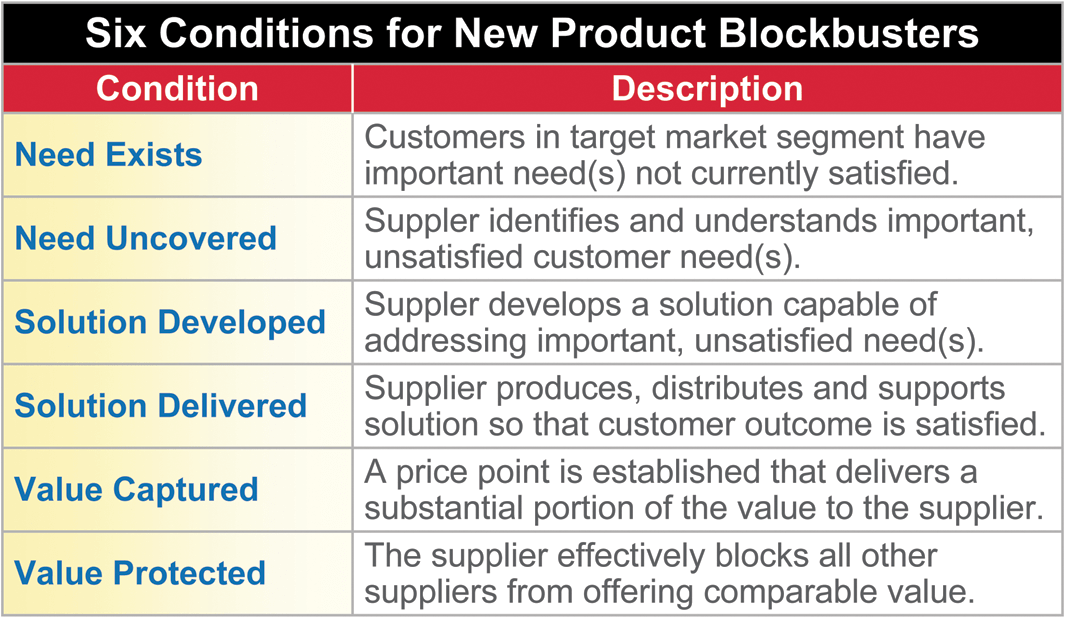
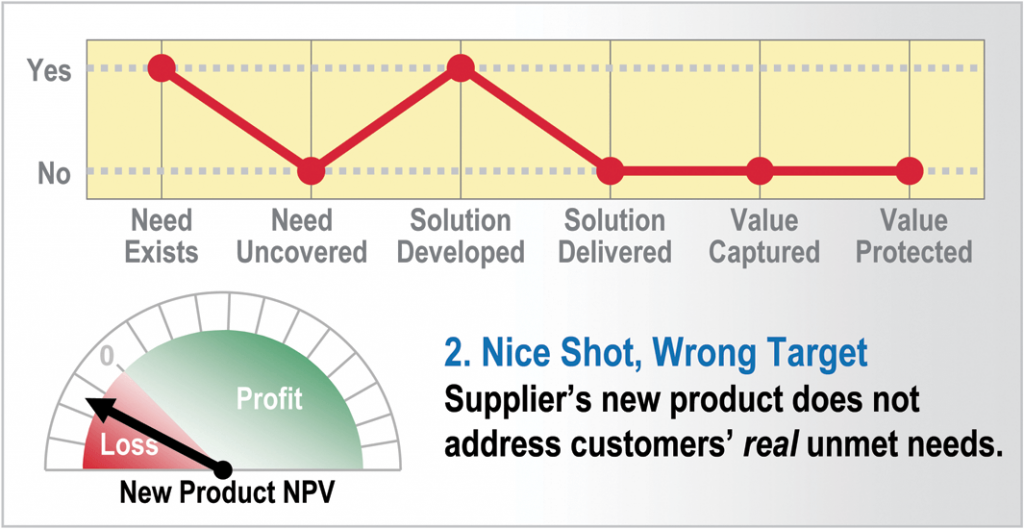
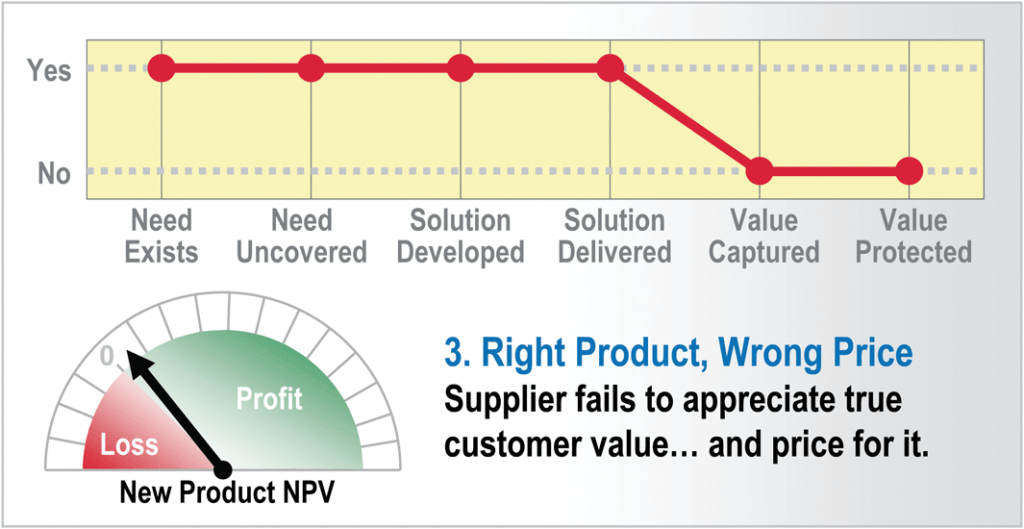
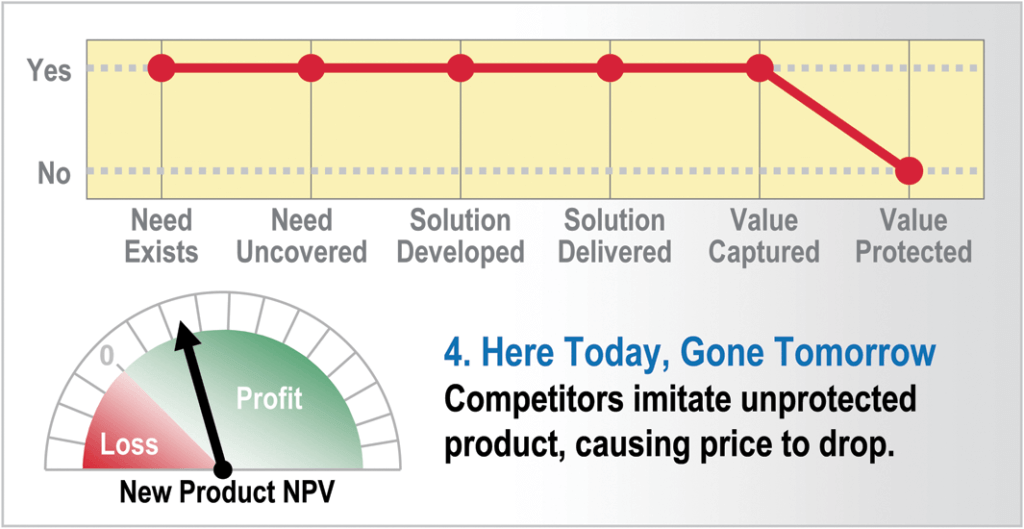
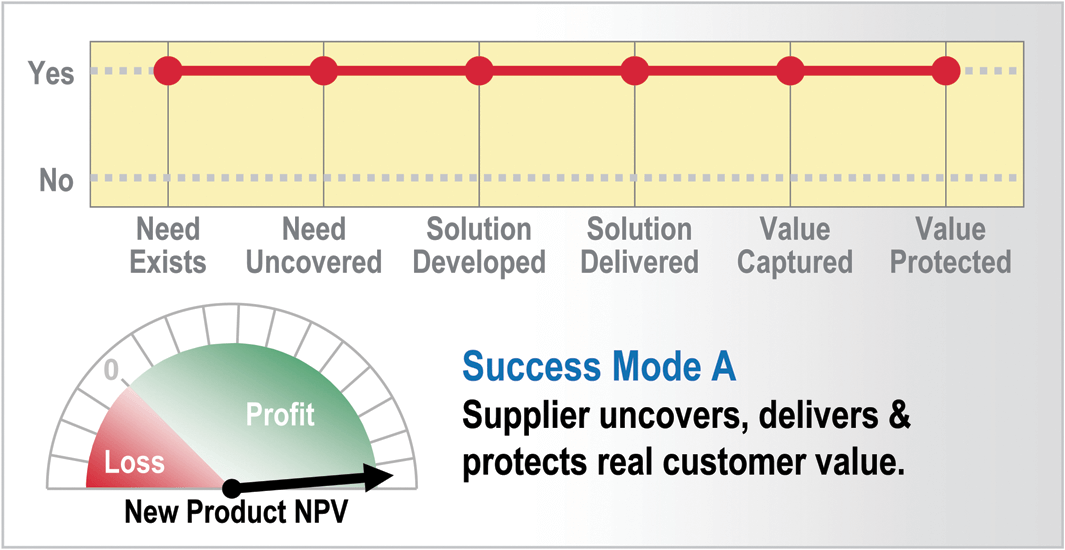
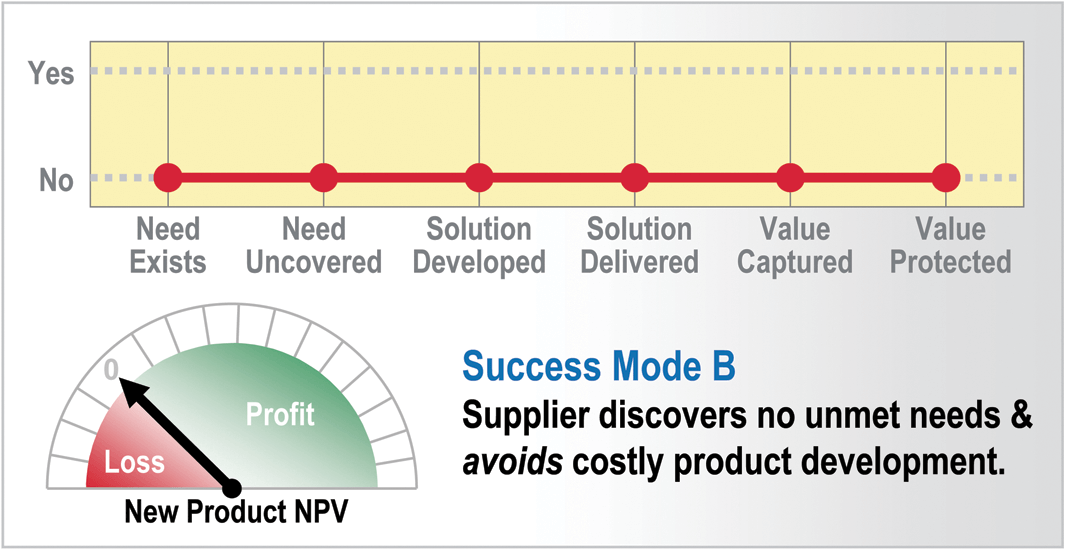
pharmacie en ligne avec ordonnance: Pharmacie en ligne France – pharmacie en ligne pharmafst.com
pharmacie en ligne livraison europe: Pharmacie en ligne France – trouver un mГ©dicament en pharmacie pharmafst.com
https://kamagraprix.shop/# kamagra oral jelly
https://pharmafst.com/# pharmacie en ligne france fiable
acheter kamagra site fiable: acheter kamagra site fiable – achat kamagra
https://tadalmed.shop/# Tadalafil 20 mg prix sans ordonnance
kamagra oral jelly: achat kamagra – kamagra oral jelly
https://pharmafst.shop/# pharmacie en ligne france livraison belgique
https://kamagraprix.shop/# Achetez vos kamagra medicaments
Acheter Cialis: Tadalafil 20 mg prix sans ordonnance – Cialis sans ordonnance 24h tadalmed.shop
pharmacie en ligne pas cher: pharmacie en ligne sans ordonnance – pharmacie en ligne france pas cher pharmafst.com
Kamagra pharmacie en ligne: kamagra 100mg prix – kamagra en ligne
http://kamagraprix.com/# achat kamagra
trouver un mГ©dicament en pharmacie: Medicaments en ligne livres en 24h – pharmacie en ligne livraison europe pharmafst.com
pharmacie en ligne france pas cher: pharmacie en ligne sans ordonnance – pharmacie en ligne france livraison internationale pharmafst.com
https://kamagraprix.com/# Kamagra Oral Jelly pas cher
Achetez vos kamagra medicaments: kamagra livraison 24h – kamagra 100mg prix
Cialis generique prix: Tadalafil achat en ligne – Tadalafil 20 mg prix en pharmacie tadalmed.shop
https://kamagraprix.shop/# Kamagra pharmacie en ligne
pharmacie en ligne pas cher: Meilleure pharmacie en ligne – pharmacie en ligne france fiable pharmafst.com
pharmacie en ligne fiable: Livraison rapide – pharmacie en ligne pharmafst.com
http://tadalmed.com/# Acheter Cialis 20 mg pas cher
Pharmacie en ligne Cialis sans ordonnance: Cialis sans ordonnance 24h – Acheter Cialis tadalmed.shop
acheter mГ©dicament en ligne sans ordonnance: pharmacie en ligne sans ordonnance – acheter mГ©dicament en ligne sans ordonnance pharmafst.com
http://pharmafst.com/# Pharmacie en ligne livraison Europe
Cialis en ligne: Tadalafil 20 mg prix sans ordonnance – Tadalafil 20 mg prix en pharmacie tadalmed.shop
pharmacie en ligne fiable: pharmacie en ligne pas cher – Achat mГ©dicament en ligne fiable pharmafst.com
http://pharmafst.com/# pharmacie en ligne avec ordonnance
Achat mГ©dicament en ligne fiable: Pharmacie en ligne France – pharmacie en ligne france livraison belgique pharmafst.com
Acheter Cialis 20 mg pas cher: Tadalafil 20 mg prix en pharmacie – Tadalafil 20 mg prix en pharmacie tadalmed.shop
https://tadalmed.com/# Cialis sans ordonnance pas cher
kamagra gel: Acheter Kamagra site fiable – kamagra 100mg prix
Achetez vos kamagra medicaments: Kamagra Oral Jelly pas cher – kamagra pas cher
https://tadalmed.com/# cialis generique
Tadalafil 20 mg prix sans ordonnance: Cialis sans ordonnance 24h – Tadalafil 20 mg prix en pharmacie tadalmed.shop
kamagra en ligne: achat kamagra – kamagra oral jelly
kamagra oral jelly: achat kamagra – Kamagra Commander maintenant
https://tadalmed.com/# Tadalafil achat en ligne
Tadalafil 20 mg prix sans ordonnance: Acheter Cialis – Acheter Viagra Cialis sans ordonnance tadalmed.shop
achat kamagra kamagra gel achat kamagra
Tadalafil sans ordonnance en ligne: cialis sans ordonnance – Tadalafil achat en ligne tadalmed.shop
https://kamagraprix.com/# kamagra pas cher
Cialis sans ordonnance pas cher Acheter Cialis Cialis sans ordonnance pas cher tadalmed.com
Kamagra Commander maintenant: Achetez vos kamagra medicaments – Kamagra Oral Jelly pas cher
http://pharmafst.com/# pharmacie en ligne france fiable
kamagra 100mg prix achat kamagra kamagra pas cher
kamagra en ligne: Acheter Kamagra site fiable – kamagra oral jelly
https://pharmafst.com/# Achat mГ©dicament en ligne fiable
Kamagra Commander maintenant: Kamagra Oral Jelly pas cher – kamagra 100mg prix
https://tadalmed.shop/# Cialis en ligne
trouver un mГ©dicament en pharmacie pharmacie en ligne pas cher pharmacie en ligne pas cher pharmafst.shop
achat kamagra: kamagra 100mg prix – kamagra gel
https://kamagraprix.shop/# kamagra pas cher
Achetez vos kamagra medicaments kamagra gel kamagra 100mg prix
cialis sans ordonnance: Cialis sans ordonnance pas cher – Tadalafil 20 mg prix en pharmacie tadalmed.shop
https://kamagraprix.com/# kamagra en ligne
Pharmacie Internationale en ligne pharmacie en ligne sans ordonnance Pharmacie en ligne livraison Europe pharmafst.shop
vente de mГ©dicament en ligne: pharmacie en ligne – Pharmacie sans ordonnance pharmafst.com
https://kamagraprix.com/# achat kamagra
Cialis sans ordonnance 24h Acheter Cialis Cialis sans ordonnance 24h tadalmed.com
achat kamagra: kamagra livraison 24h – acheter kamagra site fiable
https://kamagraprix.com/# Kamagra Commander maintenant
olympe casino cresus: olympe – olympe casino avis
casino olympe casino olympe
olympe casino en ligne olympe
olympe casino avis: olympe casino en ligne – casino olympe
olympe casino en ligne: olympe casino – olympe casino
olympe casino olympe
https://olympecasino.pro/# olympe casino en ligne
olympe casino en ligne olympe casino
olympe casino en ligne: olympe casino en ligne – olympe casino en ligne
olympe casino olympe
olympe casino cresus: olympe casino en ligne – olympe
olympe casino avis olympe
olympe: casino olympe – olympe casino avis
olympe casino en ligne olympe
casino olympe: casino olympe – olympe casino
olympe casino cresus olympe
olympe casino cresus casino olympe
olympe casino avis: olympe casino avis – casino olympe
olympe casino en ligne olympe
https://olympecasino.pro/# olympe casino avis
casino olympe: olympe – olympe casino
olympe casino avis olympe casino avis
olympe casino olympe casino cresus
casino olympe: olympe casino avis – olympe casino cresus
olympe casino avis olympe casino avis
olympe: olympe – olympe
olympe olympe
olympe: olympe – casino olympe
olympe casino en ligne olympe
olympe: olympe – olympe
olympe casino en ligne olympe casino avis
olympe casino en ligne: olympe casino en ligne – olympe
olympe casino olympe casino cresus
olympe casino en ligne: olympe casino en ligne – olympe casino avis
olympe casino cresus olympe
olympe casino cresus: olympe casino avis – casino olympe
olympe casino cresus: olympe casino en ligne – casino olympe
casino olympe casino olympe
https://olympecasino.pro/# casino olympe
olympe casino avis: olympe casino – olympe casino avis
olympe casino en ligne olympe casino
olympe casino olympe casino cresus
olympe casino cresus olympe casino en ligne
olympe casino cresus olympe casino en ligne
https://olympecasino.pro/# casino olympe
casino olympe: casino olympe – casino olympe
casino olympe olympe casino
https://olympecasino.pro/# olympe
olympe casino: casino olympe – olympe casino
olympe casino cresus: olympe casino cresus – olympe casino cresus
canadian pharmacy 24h com USACanadaPharm legal canadian pharmacy online
USACanadaPharm: pharmacy canadian superstore – cheap canadian pharmacy
USACanadaPharm: legit canadian pharmacy – USACanadaPharm
USACanadaPharm: pet meds without vet prescription canada – usa canada pharm
USACanadaPharm usa canada pharm canadian pharmacy victoza
buy drugs from canada: USACanadaPharm – usa canada pharm
usa canada pharm: usa canada pharm – USACanadaPharm
canadian pharmacy uk delivery: canadian pharmacies online – usa canada pharm
USACanadaPharm: canadian drug pharmacy – best canadian pharmacy
usa canada pharm usa canada pharm USACanadaPharm
usa canada pharm: canadian pharmacy 24 – canadian pharmacy online store
canadian drug pharmacy: usa canada pharm – USACanadaPharm
safe canadian pharmacy: best canadian pharmacy to buy from – online canadian pharmacy
USACanadaPharm canadian pharmacy meds USACanadaPharm
northwest pharmacy canada: USACanadaPharm – canadian pharmacy world
precription drugs from canada: precription drugs from canada – buy drugs from canada
USACanadaPharm: usa canada pharm – canadian pharmacy online
usa canada pharm usa canada pharm legitimate canadian pharmacy online
USACanadaPharm: canada drugs online – usa canada pharm
best canadian pharmacy: USACanadaPharm – usa canada pharm
medication canadian pharmacy: USACanadaPharm – USACanadaPharm
onlinepharmaciescanada com canadian drugs online canadian neighbor pharmacy
canadapharmacyonline legit: USACanadaPharm – usa canada pharm
usa canada pharm USACanadaPharm prescription drugs canada buy online
USACanadaPharm: canada drug pharmacy – USACanadaPharm
Online medicine order: india online pharmacy – UsaIndiaPharm
USA India Pharm: UsaIndiaPharm – pharmacy website india
indian pharmacy paypal buy medicines online in india indian pharmacy online
USA India Pharm: USA India Pharm – indian pharmacies safe
UsaIndiaPharm: indian pharmacy – reputable indian online pharmacy
indianpharmacy com Online medicine order top 10 online pharmacy in india
UsaIndiaPharm: top 10 online pharmacy in india – UsaIndiaPharm
UsaIndiaPharm: UsaIndiaPharm – USA India Pharm
UsaIndiaPharm: USA India Pharm – USA India Pharm
indian pharmacy: indianpharmacy com – USA India Pharm
USA India Pharm online shopping pharmacy india indianpharmacy com
UsaIndiaPharm: india pharmacy mail order – USA India Pharm
best online pharmacy india: UsaIndiaPharm – buy medicines online in india
UsaIndiaPharm: Online medicine order – п»їlegitimate online pharmacies india
indianpharmacy com UsaIndiaPharm UsaIndiaPharm
UsaIndiaPharm: online pharmacy india – UsaIndiaPharm
mail order pharmacy india: india online pharmacy – UsaIndiaPharm
UsaIndiaPharm: mail order pharmacy india – USA India Pharm
top 10 online pharmacy in india UsaIndiaPharm UsaIndiaPharm
indian pharmacies safe: Online medicine order – online shopping pharmacy india
USA India Pharm: top 10 pharmacies in india – top online pharmacy india
indian pharmacies safe: buy medicines online in india – india pharmacy mail order
Online medicine order reputable indian pharmacies п»їlegitimate online pharmacies india
USA India Pharm: top online pharmacy india – UsaIndiaPharm
UsaIndiaPharm: buy medicines online in india – USA India Pharm
USA India Pharm: Online medicine home delivery – USA India Pharm
indian pharmacies safe: Online medicine order – world pharmacy india
п»їlegitimate online pharmacies india buy medicines online in india USA India Pharm
Online medicine home delivery: USA India Pharm – world pharmacy india
UsMex Pharm: mexican pharmacy – Mexican pharmacy ship to USA
Us Mex Pharm mexican pharmacy certified Mexican pharmacy
certified Mexican pharmacy: USMexPharm – Mexican pharmacy ship to USA
mexican pharmacy: Mexican pharmacy ship to USA – mexican pharmacy
certified Mexican pharmacy: mexican pharmacy – mexican pharmacy
Us Mex Pharm: Mexican pharmacy ship to USA – certified Mexican pharmacy
certified Mexican pharmacy certified Mexican pharmacy Us Mex Pharm
Mexican pharmacy ship to USA: п»їbest mexican online pharmacies – UsMex Pharm
Mexican pharmacy ship to USA: purple pharmacy mexico price list – mexico pharmacies prescription drugs
USMexPharm: mexican pharmacy – mexican pharmacy
UsMex Pharm Us Mex Pharm USMexPharm
UsMex Pharm: certified Mexican pharmacy – Mexican pharmacy ship to USA
UsMex Pharm: Mexican pharmacy ship to USA – mexican pharmacy
usa mexico pharmacy: mexican online pharmacies prescription drugs – mexican pharmacy
Us Mex Pharm Mexican pharmacy ship to USA UsMex Pharm
usa mexico pharmacy: Us Mex Pharm – usa mexico pharmacy
Mexican pharmacy ship to USA: usa mexico pharmacy – Mexican pharmacy ship to USA
USMexPharm: Mexican pharmacy ship to USA – usa mexico pharmacy
UsMex Pharm: Mexican pharmacy ship to USA – Us Mex Pharm
slot casino siteleri slot casino siteleri deneme bonusu veren siteler casinositeleri1st.shop
en iyi casino oyunlarД±: casibom giris adresi – bahis siteleei casibom1st.com
bet siteler: casibom giris – gerГ§ek paralД± slot uygulamalarД± casibom1st.com
sweet bonanza demo sweet bonanza siteleri sweet bonanza giris sweetbonanza1st.com
deneme bonusu veren siteler: casino siteleri 2025 – deneme bonusu veren siteler casinositeleri1st.com
en az para yatД±rД±lan bahis siteleri: casibom giris – superbeting casibom1st.com
sweet bonanza slot: sweet bonanza giris – sweet bonanza giris sweetbonanza1st.shop
bahis veren siteler casibom guncel giris guvenilir bahis siteleri casibom1st.shop
sweet bonanza 1st: sweet bonanza oyna – sweet bonanza siteleri sweetbonanza1st.shop
casino siteleri: guvenilir casino siteleri – casino siteleri casinositeleri1st.com
sweet bonanza 1st: sweet bonanza oyna – sweet bonanza sweetbonanza1st.shop
slot casino siteleri: casino siteleri 2025 – casino siteleri casinositeleri1st.com
lisansl? casino siteleri lisansl? casino siteleri slot casino siteleri casinositeleri1st.shop
sweet bonanza oyna: sweet bonanza oyna – sweet bonanza siteleri sweetbonanza1st.shop
casino siteleri: casino siteleri 2025 – casino siteleri 2025 casinositeleri1st.com
sweet bonanza slot: sweet bonanza slot – sweet bonanza oyna sweetbonanza1st.shop
jav siteleri: casibom giris – casino slot siteleri casibom1st.com
en Г§ok kazandД±ran bahis siteleri: casibom mobil giris – kumar sitesi casibom1st.com
https://sweetbonanza1st.shop/# sweet bonanza yorumlar
bilinmeyen siteler: casibom guncel giris – tГјrkiye casino siteleri casibom1st.com
guvenilir casino siteleri: casino siteleri 2025 – slot casino siteleri casinositeleri1st.com
sweet bonanza demo sweet bonanza 1st sweet bonanza 1st sweetbonanza1st.com
canlД± oyunlar: casibom – casД±no casibom1st.com
casino siteleri 2025: deneme bonusu veren siteler – lisansl? casino siteleri casinositeleri1st.com
bahis oyunlarД±: casibom – canlД± bahis oyunlarД± casibom1st.com
sweet bonanza siteleri sweet bonanza siteleri sweet bonanza slot sweetbonanza1st.com
sweet bonanza siteleri: sweet bonanza – sweet bonanza demo sweetbonanza1st.shop
lisinopril 25 mg tablet: Lisin Express – Lisin Express
amoxicillin script: buy amoxicillin 500mg – can you buy amoxicillin over the counter
where to buy zithromax in canada ZithPharmOnline ZithPharmOnline
Pred Pharm Net: Pred Pharm Net – prednisone 20mg online
Pred Pharm Net: Pred Pharm Net – prednisone without rx
where to buy cheap clomid: Clom Fast Pharm – Clom Fast Pharm
ZithPharmOnline: zithromax capsules 250mg – zithromax online no prescription
AmOnlinePharm amoxicillin online pharmacy buy amoxicillin
AmOnlinePharm: AmOnlinePharm – AmOnlinePharm
cost of lisinopril in mexico: Lisin Express – prescription drug zestril
AmOnlinePharm amoxicillin 500mg without prescription AmOnlinePharm
AmOnlinePharm: can i buy amoxicillin over the counter in australia – how to get amoxicillin
AmOnlinePharm: AmOnlinePharm – antibiotic amoxicillin
ZithPharmOnline: ZithPharmOnline – zithromax tablets
purchase amoxicillin 500 mg: AmOnlinePharm – purchase amoxicillin online without prescription
where can i buy clomid without insurance Clom Fast Pharm where can i buy cheap clomid without rx
zestril drug: lisinopril 80 mg – lisinopril generic drug
Clom Fast Pharm: Clom Fast Pharm – cost generic clomid without dr prescription
Lisin Express: lisinopril 20 mg price without prescription – zestoretic online
Lisin Express cost of lisinopril 30 mg Lisin Express
AmOnlinePharm: AmOnlinePharm – amoxicillin buy no prescription
Lisin Express: Lisin Express – lisinopril 10 best price
where buy clomid price: Clom Fast Pharm – where to get clomid pills
Clom Fast Pharm: Clom Fast Pharm – can i buy cheap clomid price
ZithPharmOnline zithromax azithromycin ZithPharmOnline
zithromax order online uk: ZithPharmOnline – zithromax 250 mg pill
canada ed drugs: go canada pharm – legit canadian pharmacy online
canadian pharmacies comparison: go canada pharm – canada drugs online review
п»їbest mexican online pharmacies: Agb Mexico Pharm – Agb Mexico Pharm
www india pharm: buy medicines online in india – www india pharm
Agb Mexico Pharm: mexican rx online – mexican drugstore online
canadapharmacyonline legit canadianpharmacymeds canadian pharmacy cheap
Agb Mexico Pharm: Agb Mexico Pharm – Agb Mexico Pharm
canadian pharmacy com: GoCanadaPharm – canadian pharmacy 24h com safe
Agb Mexico Pharm medicine in mexico pharmacies best online pharmacies in mexico
Agb Mexico Pharm: purple pharmacy mexico price list – п»їbest mexican online pharmacies
Agb Mexico Pharm: Agb Mexico Pharm – mexican border pharmacies shipping to usa
top 10 online pharmacy in india: top 10 online pharmacy in india – reputable indian pharmacies
mexico drug stores pharmacies mexican rx online Agb Mexico Pharm
www india pharm: reputable indian online pharmacy – online shopping pharmacy india
top 10 pharmacies in india: www india pharm – top 10 pharmacies in india
Agb Mexico Pharm: medicine in mexico pharmacies – Agb Mexico Pharm
www india pharm www india pharm www india pharm
best online pharmacy india: indian pharmacy paypal – www india pharm
mexican drugstore online: buying prescription drugs in mexico – Agb Mexico Pharm
rate canadian pharmacies: go canada pharm – canadian pharmacy drugs online
www india pharm www india pharm www india pharm
Agb Mexico Pharm: mexican mail order pharmacies – mexico drug stores pharmacies
indian pharmacy online: www india pharm – www india pharm
Kamagra online bestellen: Kamagra Oral Jelly – Kamagra online bestellen
Beste online drogist Online apotheek Nederland zonder recept Beste online drogist
https://apotheekmax.com/# ApotheekMax
Online apotheek Nederland met recept: Online apotheek Nederland met recept – Beste online drogist
https://apotekonlinerecept.com/# apotek online recept
apotek pa nett Apoteket online apotek online
de online drogist kortingscode: Betrouwbare online apotheek zonder recept – de online drogist kortingscode
https://apotheekmax.shop/# Betrouwbare online apotheek zonder recept
https://apotekonlinerecept.com/# Apoteket online
Betrouwbare online apotheek zonder recept: Apotheek online bestellen – Beste online drogist
Kamagra kaufen ohne Rezept Kamagra kaufen ohne Rezept Kamagra Gel
https://apotheekmax.com/# Apotheek online bestellen
Apotek hemleverans recept: apotek online recept – Apotek hemleverans recept
apotek online: Apotek hemleverans idag – apotek online
http://apotheekmax.com/# Apotheek online bestellen
Beste online drogist de online drogist kortingscode Betrouwbare online apotheek zonder recept
Betrouwbare online apotheek zonder recept: Apotheek Max – online apotheek
http://apotekonlinerecept.com/# Apoteket online
ApotheekMax de online drogist kortingscode Apotheek online bestellen
Kamagra kaufen: Kamagra online bestellen – Kamagra Original
https://apotheekmax.shop/# online apotheek
Kamagra online bestellen: Kamagra Oral Jelly – Kamagra Oral Jelly kaufen
https://apotheekmax.com/# Online apotheek Nederland zonder recept
de online drogist kortingscode de online drogist kortingscode de online drogist kortingscode
Online apotheek Nederland met recept: Online apotheek Nederland zonder recept – ApotheekMax
http://kamagrapotenzmittel.com/# Kamagra Oral Jelly kaufen
Kamagra Oral Jelly: Kamagra Original – Kamagra kaufen ohne Rezept
Apotek hemleverans recept apotek online recept Apotek hemleverans idag
http://apotheekmax.com/# Apotheek Max
пин ап казино зеркало – пин ап казино
пин ап казино зеркало: https://pinupkz.life/
Generic100mgEasy Generic100mgEasy Generic100mgEasy
пин ап вход – пин ап
пин ап зеркало: https://pinupkz.life/
пин ап казино – пин ап казино
пин ап вход: https://pinupkz.life/
Buy generic 100mg Viagra online Generic100mgEasy Generic 100mg Easy
пин ап казино зеркало – пин ап вход
пинап казино: https://pinupkz.life/
пин ап казино – pinup 2025
Generic 100mg Easy Generic100mgEasy Generic100mgEasy
пин ап: https://pinupkz.life/
пин ап вход – пинап казино
пинап казино: https://pinupkz.life/
пин ап вход – пин ап
TadalafilEasyBuy.com Cialis without a doctor prescription Tadalafil Easy Buy
пин ап зеркало: https://pinupkz.life/
пин ап вход – пинап казино
пин ап зеркало: https://pinupkz.life/
kamagra 100mg kopen: kamagra kopen nederland – KamagraKopen.pro
Generic100mgEasy buy generic 100mg viagra online buy generic 100mg viagra online
https://generic100mgeasy.shop/# Generic 100mg Easy
buy generic 100mg viagra online: Generic100mgEasy – Generic 100mg Easy
https://kamagrakopen.pro/# kamagra jelly kopen
buy generic 100mg viagra online buy generic 100mg viagra online Generic 100mg Easy
TadalafilEasyBuy.com: cialis without a doctor prescription – Cheap Cialis
http://generic100mgeasy.com/# buy generic 100mg viagra online
https://tadalafileasybuy.shop/# cialis without a doctor prescription
KamagraKopen.pro: KamagraKopen.pro – kamagra 100mg kopen
KamagraKopen.pro Officiele Kamagra van Nederland kamagra 100mg kopen
https://generic100mgeasy.com/# buy generic 100mg viagra online
Officiele Kamagra van Nederland: kamagra pillen kopen – Kamagra
http://tadalafileasybuy.com/# TadalafilEasyBuy.com
Kamagra Kopen KamagraKopen.pro kamagra pillen kopen
KamagraKopen.pro: Kamagra – kamagra 100mg kopen
https://kamagrakopen.pro/# kamagra pillen kopen
kamagra kopen nederland: Kamagra – Officiele Kamagra van Nederland
cialis without a doctor prescription TadalafilEasyBuy.com Generic Cialis without a doctor prescription
http://tadalafileasybuy.com/# Generic Cialis price
Kamagra Kopen Online: Kamagra Kopen Online – kamagra jelly kopen
https://kamagrakopen.pro/# kamagra kopen nederland
kamagra 100mg kopen kamagra kopen nederland kamagra 100mg kopen
kamagra kopen nederland: kamagra kopen nederland – kamagra 100mg kopen
https://tadalafileasybuy.com/# Buy Tadalafil 20mg
Generic 100mg Easy: Generic 100mg Easy – Generic100mgEasy
India Med Fast India Med Fast India Med Fast
Mexican Pharm Inter: buying from online mexican pharmacy – mexican pharmacy online store
https://interpharmonline.com/# pharmacy in canada
canadian pharmacy review
IndiaMedFast.com IndiaMedFast buying prescription drugs from india
http://mexicanpharminter.com/# mexican pharmacy online order
safe reliable canadian pharmacy
www canadianonlinepharmacy: online canadian pharmacy no prescription – canadian drug stores
http://interpharmonline.com/# reputable canadian pharmacy
best canadian online pharmacy
buying prescription drugs from india: India Med Fast – cheapest online pharmacy india
mexican pharmacy online store MexicanPharmInter Mexican Pharm International
http://interpharmonline.com/# ordering drugs from canada
my canadian pharmacy review
canadian king pharmacy: certified canada pharmacy online – canada ed drugs
http://interpharmonline.com/# canadian online drugstore
my canadian pharmacy review
ed drugs online from canada: Inter Pharm Online – adderall canadian pharmacy
canadian pharmacy Pharmacies in Canada that ship to the US canadian pharmacy review
https://interpharmonline.com/# online canadian pharmacy
canadian pharmacy victoza
certified canadian international pharmacy: canada pharmacy no prescription – my canadian pharmacy
https://interpharmonline.com/# canada rx pharmacy
reputable canadian pharmacy
canadapharmacyonline com InterPharmOnline.com canadian neighbor pharmacy
canadian drugstore online: Online pharmacy USA – trusted canadian pharmacy
alo789 chinh th?c: alo789hk – alo 789